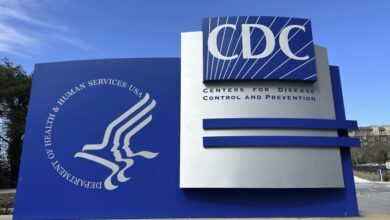CDC paper on lead poisoning investigation reveals what it’s lost

The lead-poisoning-from-applesauce case that became a national scandal started with just two children in Hickory, N.C. with concerning blood test results. In June 2023, a state inspector, along with local health officials, began investigating the source of the lead poisoning. Using an X-ray fluorescence analyzer, they tested various surfaces in the children’s home for lead contamination but found nothing significant. It was only after the mother mentioned that her children ate applesauce packets every day that the investigation took a new turn.
What followed was a nationwide investigation that revealed 566 lead-poisoned children across 44 states, Puerto Rico, and Washington, D.C. The tainted applesauce was eventually removed from shelves, but the process was not without its challenges. The CDC, which played a crucial role in coordinating the response and alerting other state health departments, had recently laid off several key experts due to budget cuts. This loss of expertise raised concerns about the agency’s ability to respond effectively to similar public health threats in the future.
The CDC’s Morbidity and Mortality Weekly Report (MMWR), a renowned public health journal, has been a vital resource for disseminating important research findings and shaping public health interventions. However, recent layoffs at the CDC have raised questions about the agency’s ability to continue producing high-quality research and providing guidance on critical public health issues. The loss of experienced scientists and researchers could have far-reaching implications for public health initiatives across the country.
Despite assurances from the Department of Health and Human Services that lead poisoning prevention efforts will continue under the new Administration for a Healthy America, the absence of key CDC experts raises concerns about the agency’s capacity to address emerging public health threats effectively. The recent layoffs have underscored the importance of investing in public health infrastructure and ensuring that agencies like the CDC have the resources and expertise needed to protect the health and well-being of the population. The CDC’s focus on specific populations, such as those in mental health facilities, has led to significant improvements in tobacco cessation programs. However, a recent study has shown that there are still gaps in these programs, particularly in the area of nicotine replacement therapy.
The study, published in the Morbidity and Mortality Weekly Report (MMWR), highlighted the importance of targeting populations with mental health issues for tobacco cessation interventions. The CDC’s requirement for states to focus on this population has resulted in the allocation of funding for tobacco cessation programs in mental health facilities. This has led to positive outcomes, with many individuals in these facilities successfully quitting tobacco use.
Despite these successes, the study also identified areas for improvement. One of the key findings was the lack of access to nicotine replacement therapy in mental health facilities. Nicotine replacement therapy, such as nicotine patches or gum, can be an effective tool in helping individuals quit smoking. However, the study found that many mental health facilities did not offer these options to their residents.
The lack of access to nicotine replacement therapy was concerning to public health officials and clinicians. They recognized the importance of providing comprehensive support to individuals trying to quit smoking, including access to medications that can help manage nicotine cravings.
The study also highlighted the broader challenges facing public health initiatives in the current political climate. The elimination of programs such as the Office on Smoking and Health and the Childhood Lead Poisoning Prevention Program has raised concerns about the future of public health interventions.
One example cited in the study was the case of lead-contaminated applesauce. The CDC’s childhood lead poisoning prevention program played a crucial role in identifying and addressing cases of lead poisoning in children. Without this program, public health officials in states like North Carolina would struggle to identify and respond to lead exposure in children.
The study emphasized the importance of continued support for public health programs and initiatives. It highlighted the critical role that these programs play in protecting the health and well-being of communities across the country.
As public health officials grapple with challenges like the opioid epidemic, emerging infectious diseases, and environmental health risks, the need for robust public health infrastructure has never been greater. The study served as a reminder of the vital role that the CDC and other public health agencies play in safeguarding the health of the population. The recent decision to disband the lead poisoning prevention team at the CDC has left many people concerned about the future of public health efforts in this area. One such person is Norman from North Carolina, who used to work closely with CDC scientists on a weekly basis. Now, with the team gone, he finds it hard to sleep at night wondering what will happen in October.
The Health and Human Services official assured that the work of the lead poisoning prevention program will continue as the department finalizes its reorganization plans. However, the details of this continuation, including staffing and funding, remain unclear. This uncertainty has left many in the public health community feeling anxious about the future of lead poisoning prevention efforts.
The disbanding of the lead poisoning prevention team is part of a larger reorganization effort within HHS. While the department is looking into all strategic programs and priorities, the impact on public health initiatives like lead poisoning prevention remains to be seen. Without the expertise and resources of the CDC team, states may struggle to effectively address lead poisoning in their communities.
It is crucial for public health officials, policymakers, and advocates to continue pushing for strong lead poisoning prevention measures, even in the absence of the CDC team. Collaboration and coordination will be key in ensuring that efforts to address lead poisoning are not derailed by organizational changes within HHS.
As Norman and others grapple with the uncertainty surrounding the future of lead poisoning prevention, it is clear that the work must continue. Public health is a collective responsibility, and it will take the efforts of many to protect communities from the dangers of lead exposure. The disbanding of the CDC team may have created a challenge, but it is one that can be overcome with dedication and collaboration.





